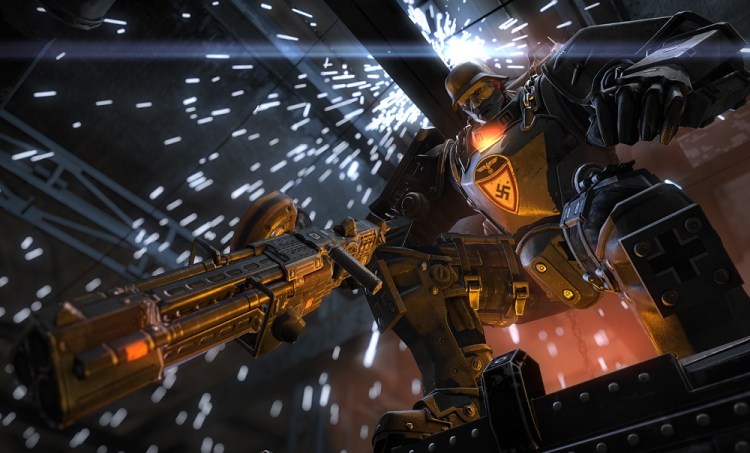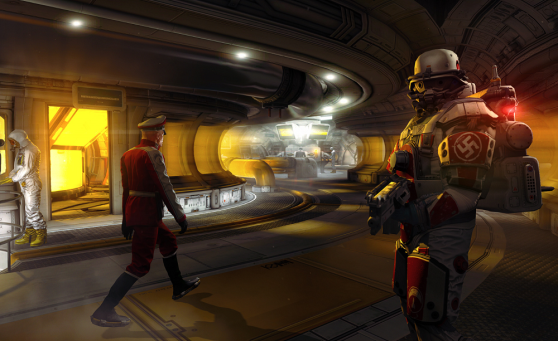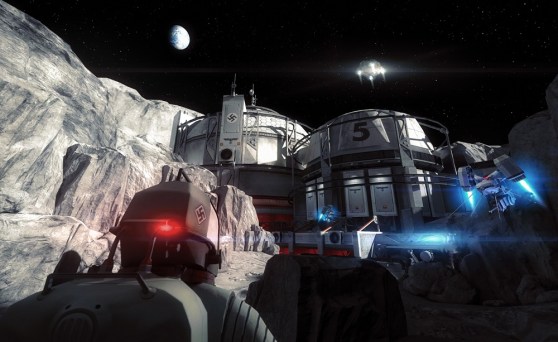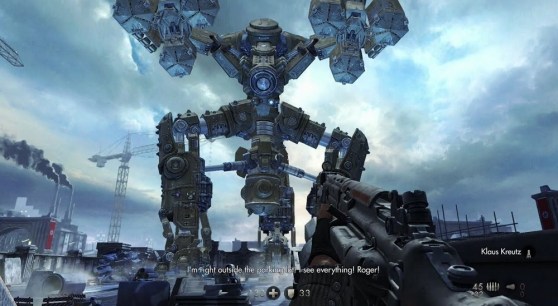GamesBeat: The added difficulty was the commanders, where they would call in reinforcements if you didn’t kill them.
Gustafsson: Yeah. We always thought that was interesting approach, to have the commanders know something, and also give the player a reward. If you were quick enough to take out the commander, the combat will be easier as you progress through and take care of that area.
GamesBeat: You had to be careful about where you placed the commanders, then?
Gustafsson: In the earlier levels, we put them pretty much in the open, to give players an understanding of where the system worked. But in the harder fights toward the end, we always wanted the commanders to fall back a bit, to make sure that the soldiers were the ones doing the combat and the commander was a little bit behind. If you sneak around a little bit in a tactical way, using the silencer or a very careful shot to get rid of them, that will benefit you in the following scenario.
GamesBeat: There were a couple of levels where I thought that if I didn’t kill the commander, there was just no way I was going to survive. I ran into that feeling more than once.
Gustafsson: It is a lot easier if you manage to take out the commander quickly. Which was the intention on our side.
GamesBeat: One of the levels was where you had the big circle. There were a couple of layers to the circle. You had to take out a whole bunch of enemies that would come into—It was still on Earth, just after you get through —
Gustafsson: Was this late in the game?
GamesBeat: It felt more like the middle. I can’t remember if it was before or after the hangar. It was a big stadium, almost? Anyway, that was one of the levels where I felt like I tried to fight it without taking out the commanders first, and then I remembered the commanders and I finally got through it. The other feeling I had was that—How many levels were there again? 16 chapters or so?
Gustafsson: Yeah, 16 chapters.
GamesBeat: By level 12, once I’d finished with the moon, I thought the game was going to be over by then. I had fought so much, fought so many big bosses, and gotten all the way to the top of the moon—It seemed like this was all so hard that it seemed like the game should have been over.
Gustafsson: Did you always play on Bring ‘Em On, the medium difficulty?
GamesBeat: It was somewhere around medium. It was maybe the third of five? Is that how many levels there were?
Gustafsson: Yeah, we have five. Number three is the default one. It’s pretty challenging, although it’s a bit easier if you play on PC of course. On console it’s more challenging.
GamesBeat: Can you talk about that part of the game, where you made these—The story went longer. The bosses were more difficult. Especially the big giant monster boss, the one that’s as big as London or whatever? I don’t know if that was level 12 or 13 or so. Even that was an extremely difficult boss. I felt like I went from boss level to boss level and I was finally done after that. It was like there were four major endings.
Gustafsson: Yeah. When you return from the moon level, you play through the London Nautica – Chapter 15 — level, and then you come after this big London Monitor, which is a bit challenging, especially if you don’t know what to do and have to figure out how to approach it. Then you go back to the headquarters, which is a pretty short level, but we also had the [Panzerhund] fight in the hangar, before you eventually come to the last level, which is a pretty big challenge. The boss fights there are pretty much [three different boss fights]. There are a lot of challenges toward the end of the game, especially the last couple of hours.
GamesBeat: I think that with the London Monitor, I died about 30 times.
Gustafsson: I’m sorry about that.
GamesBeat: Or it felt like that. I don’t know actually how many.
Gustafsson: At least it’s fairly easy to continue, though, right after you left off.
GamesBeat: It took me a while to figure out what to do. I think there was almost so much freedom to move around and do things that it took a lot of experimentation before you figured out how to take out the boss.
Gustafsson: Any game you develop, especially a game with this kind of dynamic combat, bosses are pretty much the hardest gameplay to do. You have to communicate to the player what they should do. It’s very difficult. It usually ends up taking a lot of time for players to learn how to plan and how to assault it.
GamesBeat: I felt like the Monitor was probably a harder level than the actual final level of the game. I felt that if I used a lot of rockets in that last level and kept on reloading near the ammo point, then I could take out all the enemies with those rockets.
Gustafsson: Here’s a question for you. In terms of picking up health and upgrades for the basic weapons, did you put in a lot of time on that, or did you try to play through as quickly as possible? That can make the game pretty hard, but people who are exploring and upgrading the weapons, it usually becomes pretty easy for them. It’s hard to balance. If you don’t do anything, it gets a lot harder after a certain point.
GamesBeat: Let’s see. The very final, final level, I did have a very hard time. I was forgetting about that very final level. That side was very difficult, for sure. The level before that was the one that was somewhat easier. I didn’t really do too many upgrades. I did read everything I could. I tried to find as many secrets as I could. But I wasn’t actually doing a lot of upgrades to the basic soldier.
Gustafsson: If you’ve played through from the beginning to the end without caring too much about exploring, if you haven’t found anything to make it easier, then it can become really difficult. If you do explore, it does become a little bit easier. If you’re really rushing and don’t care about anything, then of course it might be a bit harder. It’s a difficult thing to balance, as I say. Finding things should be a bonus for you and not a penalty. That’s usually the approach we have.
GamesBeat: With the two different levels fighting Death’s Head, it was difficult, because I didn’t know what was working against him. It took quite a while to find out how he was vulnerable. I think I died a lot there as well. Just a normal grenade or something like that has almost no effect, right? But once I figured out some things like that guns on the side, then it became a lot easier. If you have to summarize this, how is Wolfenstein different from other shooters? What did you learn about making this game? How do you take in a lot of the feedback you get about the experience players have had?
Gustafsson: For me, the intention from the beginning was to have—A lot of our idea around this product was to make it a throwback, a little bit, to the classic shooter style. The intention was to have it be a little more difficult than some of the other shooters of today. Obviously you don’t want players to be frustrated and die all the time, though.
Looking back, I think we did a pretty good job. Our medium difficulty isn’t for every player. It’s challenging. But it’s not impossible. There are still a few spikes where maybe we should have decreased it a little bit and tried to even it out. There are always things you can learn. But I would say that in general, with the medium setting, I’m happy with it.




